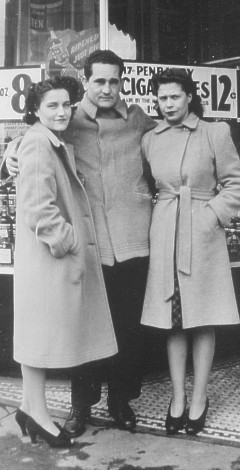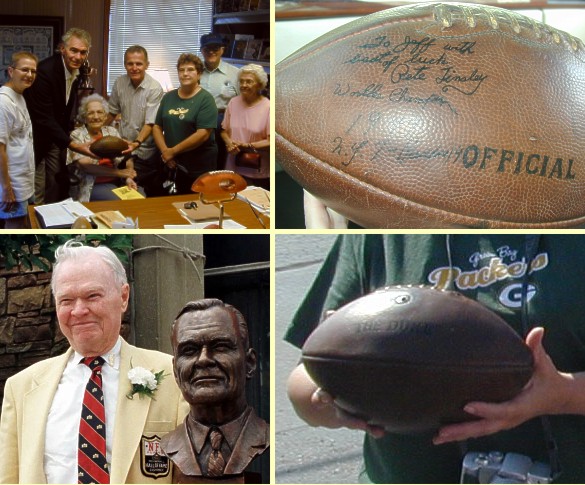
Kansas Snapshots by Gloria Freeland - April 14, 2023
Donna and "The Duke"
When I watch a program like "Antiques Roadshow" or "Pawn Stars," I'm often intrigued by how someone became the owner of an
important piece of memorabilia. So how did husband Art's cousin come to have a football used in the 1944 National Football
League championship game?
The story began with Art's mother Donna. Back in the day, most young women went to sporting events to accompany a man or meet
friends. Donna wasn't one of those. While she was a fan of several sports, she considered the others to be just appetizers for
the football season.
Her interest developed in high school. Since her father had a car dealership and there were no driving requirements in Wisconsin
in 1925, she was driving by the age of 15. She occasionally made the 30-mile trip to Green Bay to watch the Packers play at City
Stadium - which was really just the high school stadium for Green Bay East High School.

Donna in 1925. Green Bay East High School stadium, also called City Stadium, where the Packers played until 1956
Donna married Tom in 1931. He had played football in high school, but she was the one who begged their landlord to use his living
room radio on Sundays in the fall so she could listen to the Packers on Milwaukee's WTMJ radio station.
Her interest was contagious. Her dad Charles, brothers Pete and Art, and sisters Arline and Ione were soon afflicted. A chance
event in the late '30s intensified their interest. Ione was working at the hometown Ford Hopkins drugstore, when the
cosmetics-counter position opened up at its Green Bay outlet. It was one block from the Northland Hotel, where "Curly" Lambeau,
the Packers' coach and head man, had a room he used as the team's headquarters.
The drugstore also had a grill, and Packers players often dropped in for a bite to eat after stopping by the Northland. Bernice,
a refugee from the cold winters her family endured in Michigan�s Upper Peninsula, was in charge of the grill. She and Ione soon
became great friends.
While Ione frequently dated players, Bernice rebuffed the attention of Pete Tinsley, a South Carolina native who played guard
for the team. It was well known that some players had wives and families "back home," and she had no interest in becoming
involved in such a situation.
But the ice thawed when Bernice learned Pete was single.
Professional football was far different then. Players on the 30-man squads were often paid on a per-game basis for the 10-game
schedule. A member of a championship team might earn an extra $1,000 - equivalent to $17,000 today. An off-season job was
usually a necessity, and Pete painted houses or worked on the railroad to get by.
While he had a reputation of being "ornery," he won Bernice's heart. On June 21, 1942, quite on impulse, they decided to get
married. Wisconsin had a five-day waiting period, so they looked up fellow Packer Joe Laws, who had a car, and drove to
Dubuque. There was no waiting period in Iowa. Joe and Ione were the witnesses.
Arline's husband Ora had also been pulled into the family obsession with the Packers. They would drive to home games in Green Bay,
and, along with Ione, mingle with the players.
By 1944, Pete had been with the team six years - a long time in an age of poor protective gear. He repeatedly stated his days as
a player were over, but surprised others by being the first to sign a contract.
Ione, left, Pete and Bernice in front of Ford Hopkins in Green Bay

In 1944, the New York Giants won the eastern division crown and the Packers won in the west. The championship game was played on
December 17 at New York's polo grounds and the Packers won 14-7. Arline had given birth to son Jeff eight days before. While Pete
wasn't much for mementos, he did bring back a game ball. He added an inscription on "The Duke,� referencing both the victory and
Jeff's arrival.
Ione left Green Bay not long after and eventually held an important position with Revlon cosmetics in Chicago. Pete finally did
retire and he and Bernice moved to Florence, Wisconsin. They raised a family of three, while he taught industrial arts and coached
football in the local high school. Bernice cooked in the cafeteria. Donna, her sons, brothers, and Arline's husband became season
ticket holders. Then, as older family members passed, those tickets began moving on to later generations.
But Jeff wondered what to do with the ball. Since he didn't have children, the only appropriate place for it seemed to be with the
Packers. So, in 2007, he contacted Tom Murphy, then the head of the Green Bay Packers Hall of Fame. The idea was for the ball to
have one last hand-off. Donna, her sons Tommy and Art, and Jeff and his wife Lorraine traveled to Green Bay. There they met Pete's
and Bernice�s daughter Pat for the appointment with Murphy.
"The Duke" finally had a fitting home.
But what was the story behind the ball being nicknamed "The Duke?" It seems Tim Mara, founder of the New York Giants, was an
admirer of the Duke of Wellington and so named a son after him. Wellington Mara became involved with the Giants football team
and their players nicknamed him "The Duke." In 1941, the Maras were instrumental in signing a long-term agreement with Wilson
Sporting Goods to make all the footballs for the NFL - which it still does. To commemorate the occasion, the official game balls
carried the name "The Duke." It was dropped in 1970, but after Wellington's death in 2005, "The Duke" returned. The balls have
been so inscribed since.
So, much as frequently happens on "Antiques Roadshow" or "Pawn Stars," this back story isn't a big one. But digging out the
details certainly kept my interest.

Top-left: Lorraine, Tom, Donna, Jeff, Pat, Tommy, and Lorraine's mother Alice at the "hand-off"; top-right: "To Jeff with best of luck, Pete Tinsley, Worlds Champion, 1944, N.Y. 7 - Packers 14"; bottom-left: Wellington Mara at football Hall of Fame induction; bottom-right: Pat holding the ball so "The Duke" can be seen. (Mara photo, Associated Press)
Comments? [email protected].
Other columns from this year may be found at: Current year Index.
Links to previous years are on the home page: Home